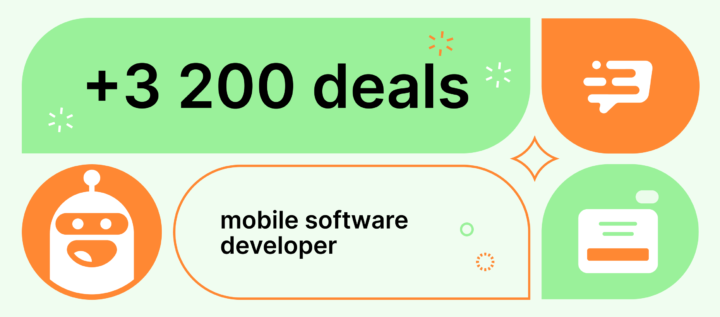Inbound vs outbound leads: Understanding their difference to master your approach
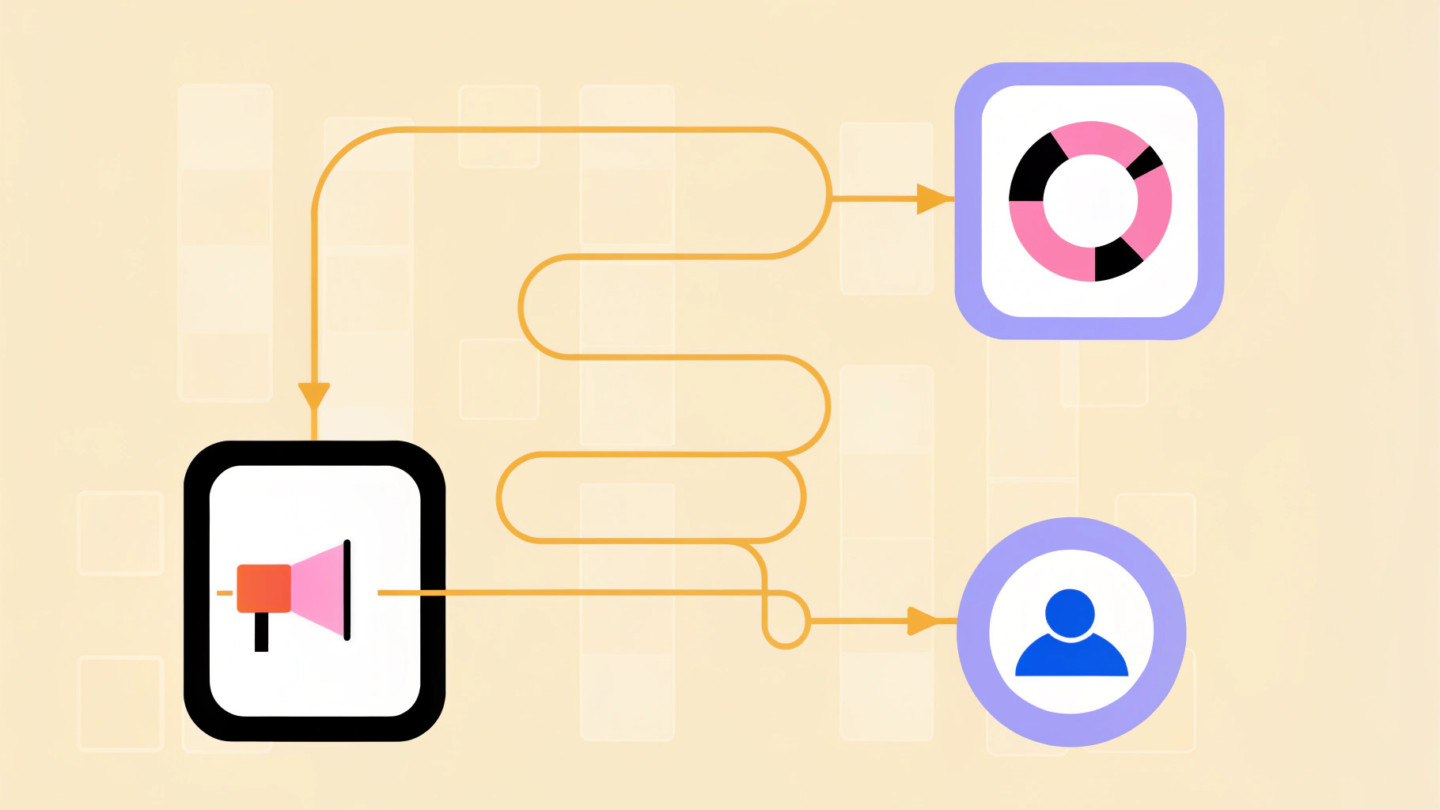
Overview
In the world of business, many marketing teams, especially smaller ones, owners grapple with the challenge of generating leads effectively. It can feel overwhelming when deciding between inbound and outbound strategies. We understand that navigating these options is crucial for your success.
Inbound leads, generated through valuable content and meaningful engagement, often prove to be a game changer. They typically yield higher conversion rates and lower acquisition costs, making them a more attractive option compared to outbound leads. Outbound methods, while sometimes necessary, can come across as intrusive, leading to frustration for both you and your potential customers.
Statistics back this up, showing that inbound marketing efforts tend to provide a greater return on investment. This isn’t just about numbers; it’s about finding a strategy that resonates with your audience and aligns with your values as a business owner.
Remember, you’re not alone in this journey. Many have faced similar struggles and found that prioritizing inbound strategies not only fosters better relationships with customers but also simplifies the lead generation process. So, take a moment to reflect on your current approach — could a shift towards inbound marketing be the solution you’ve been seeking?
Introduction
In the ever-evolving landscape of marketing, we understand that navigating the nuances between inbound and outbound lead generation can be overwhelming for businesses aiming to enhance their customer acquisition strategies. You might feel frustrated trying to figure out which approach works best for you.
- Inbound leads, attracted by valuable content and strategic engagement, offer a more organic path that fosters trust and builds long-term relationships.
- On the other hand, outbound leads are pursued proactively, often through direct outreach, yielding immediate results but sometimes lacking the same depth of engagement.
As the marketing world becomes increasingly competitive, it’s essential to recognize these distinct methods to optimize your lead generation efforts. This article will explore the key concepts, differences, advantages, and effective strategies associated with inbound and outbound leads.
By integrating both approaches, you can create a comprehensive marketing strategy that drives growth and enhances your customer relationships. You’re not alone in this journey; let’s dive in together.
Defining inbound and outbound leads: Key concepts
Inbound prospects are individuals who express interest in a company by reaching out, often after engaging with valuable content or promotions designed to capture their attention. This approach focuses on building trust through informative content, search engine optimization (SEO), and active engagement on social media platforms. On the other hand, outbound prospects arise from proactive outreach methods, such as cold calling, direct emails, and targeted advertisements, where businesses take the initiative to connect with potential customers directly.
Understanding these distinctions between inbound and outbound leads is essential. They form the foundation for evaluating the effectiveness of various generation strategies. With 77% of internet users regularly reading company blogs, it’s evident that inbound marketing can significantly boost engagement and conversion potential. As marketing specialist Thomas Radavicius points out,
Inbound marketing ROI is greater than other types of marketing
underscoring the financial benefits of attracting prospects through value-driven methods.
Moreover, utilizing Dashly‘s marketing platform allows businesses to automate prospect management, capture, nurturing, and reactivation, which can profoundly impact sales performance. Dashly provides features like chatbots for immediate customer interaction, scoring to prioritize prospects, and comprehensive analytics tools that offer insights into customer behavior. The global D2D market is projected to grow at 6.4% annually until 2030, highlighting the increasing importance of effective prospecting strategies in a competitive landscape.
Additionally, achieving sales success in 2025 necessitates a blend of traditional and digital methods for effective outreach as marketers navigate this evolving terrain. A case study on the underutilization of marketing automation tools for nurturing prospects reveals that only 5% of marketers currently utilize full-featured tools, which limits their generation effectiveness. By embracing comprehensive solutions like Dashly, which addresses these challenges through robust automation capabilities, organizations can enhance their nurturing processes and overall marketing effectiveness.
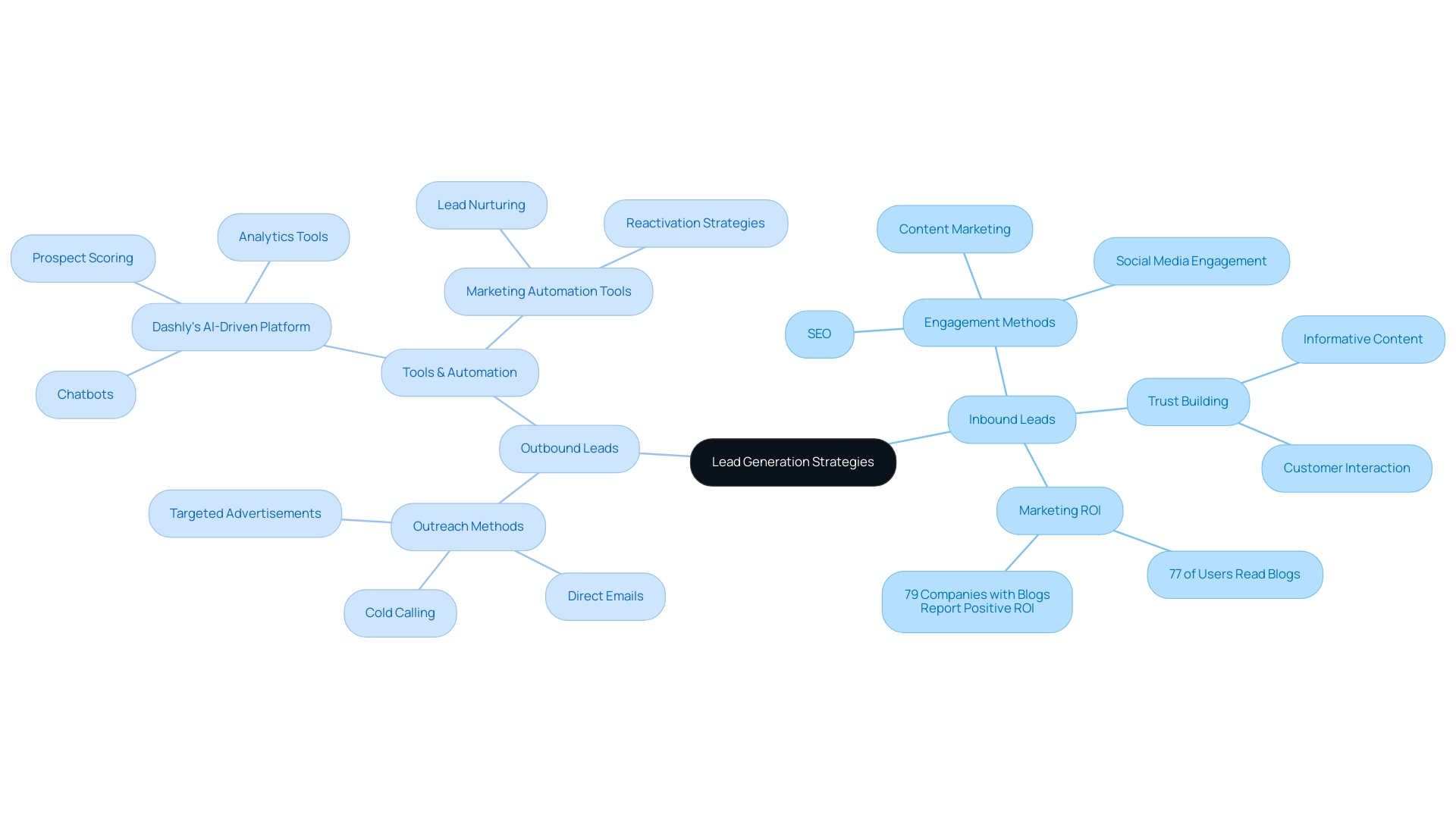
Optimize your funnel with marketing automation tools from Dashly:
Key differences between inbound and outbound leads
Navigating the world of inbound versus outbound leads can be challenging for small business owners. The distinction is clear: inbound prospects are attracted to your company through valuable content and strategic engagement. This often leads to higher quality interactions, reflecting a genuine interest in what you offer. On the other hand, outbound leads are pursued directly by businesses, which can sometimes result in lower engagement levels and higher rejection rates.
Here’s a startling fact: only 21% of prospects actually convert into sales. That means a significant 79% may not make the leap, underscoring the effectiveness of inbound strategies. While these methods might take a bit longer to cultivate relationships, they often lead to deeper engagement and greater conversion potential. A recent study reveals that 68% of B2B companies struggle to attract prospects, highlighting the urgent need for marketers to embrace successful inbound strategies like:
- content marketing
- educational blogs
- webinars
As we look ahead to 2026, incorporating robust automation software is essential for enhancing your prospect development efforts. This technology can streamline your marketing strategies and improve interactions with potential clients, making your outreach more effective and less daunting.

Pros and cons of inbound and outbound lead generation
Inbound lead generation offers numerous advantages that can truly resonate with small business owners, particularly in terms of lower customer acquisition costs and higher conversion rates. Many marketers —53% to be exact — have found that inbound marketing provides a greater return on investment (ROI) compared to just 16% for outbound efforts. This approach not only attracts customers but also fosters long-term relationships, allowing businesses to build trust and loyalty over time.
Yet, it’s important to recognize that inbound strategies can be resource-intensive. They demand a consistent commitment to content creation and search engine optimization (SEO), which can feel overwhelming for some organizations. On the other hand, outbound prospecting often delivers immediate results. By enabling targeted outreach to specific demographics, it can effectively capture attention, especially in markets where awareness is still developing.
However, we must also consider that outbound efforts can come with higher costs and may be perceived as intrusive. This perception can lead to lower engagement rates among potential customers. Striking the right balance between effective outreach and overwhelming prospects is crucial, as it can significantly influence how a brand is perceived.
With the global customer relationship management market projected to grow from $64 billion in 2022 to $146 billion by 2029, it’s essential for businesses to evaluate their strategies carefully. This growth highlights the importance of critically assessing client acquisition tactics.
Moreover, AI adoption in sales teams is expected to rise by 139% over the next three years, indicating a shift toward leveraging technology for enhanced sales efficiency. Integrating AI tools can not only improve prospect qualification but also elevate customer engagement, leading to better sales outcomes.
Additionally, social media is emerging as the most accessible touchpoint for companies, with over five billion users expected to increase to six billion by 2028. Organizations should view these channels as integral to their inbound and outbound strategies. Ultimately, the decision to emphasize inbound versus outbound leads for opportunity creation depends on the organization’s resources, market positioning, and long-term goals.
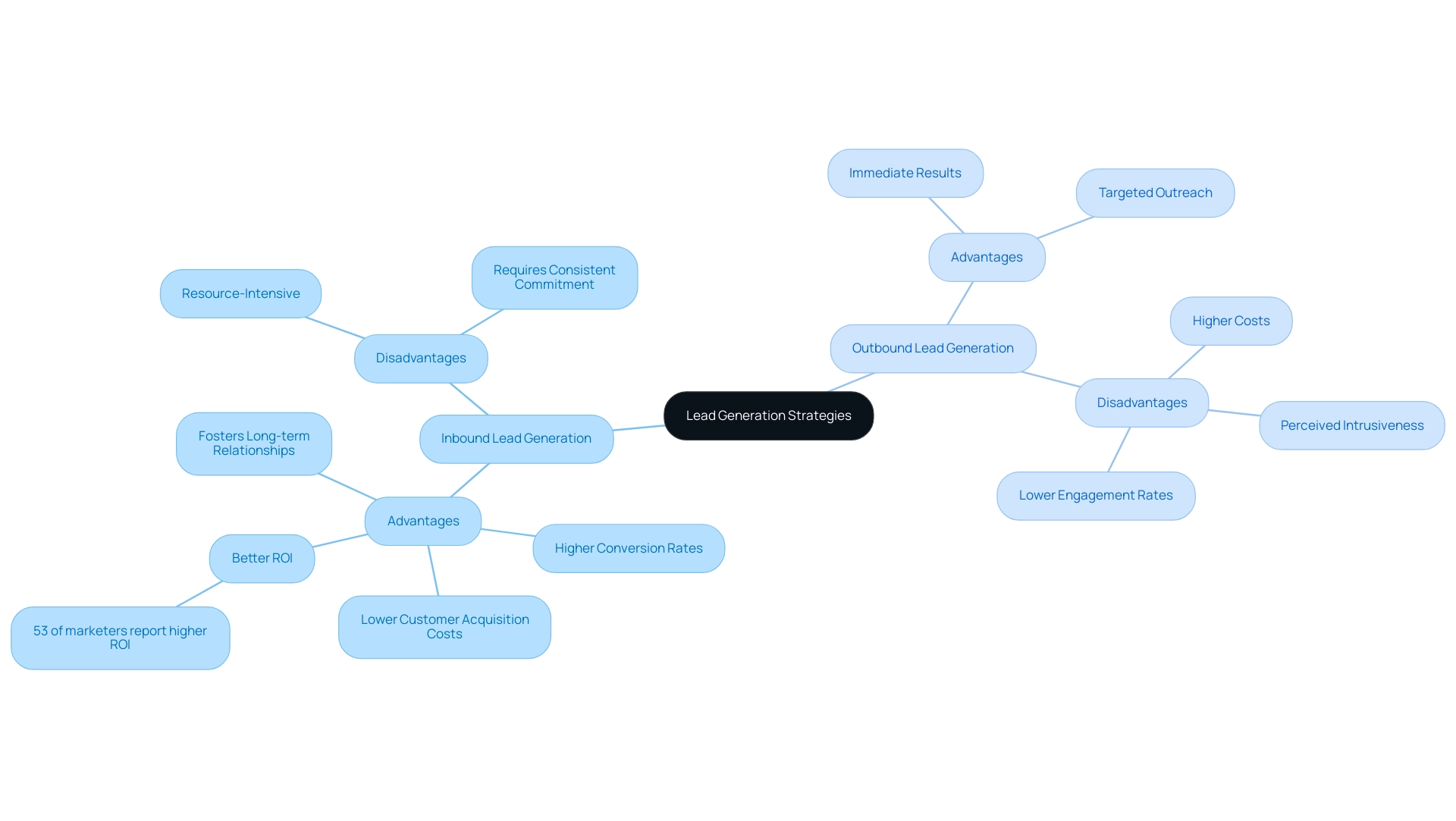
Effective strategies for inbound and outbound lead generation
To truly excel in attracting inbound prospects, it’s vital for businesses to focus on creating high-quality content that speaks directly to customer pain points. This approach ensures that your message resonates with your target audience. Additionally, optimizing your website for search engine visibility is essential; it significantly boosts your chances of attracting organic traffic. And let’s not forget the power of social media — it plays a crucial role in engaging potential customers and guiding them toward key landing pages.
In fact, did you know that over 52% of marketers actively use social media to promote these pages? This strategy can significantly enhance targeted traffic and customer acquisition. A case study titled ‘Promoting Landing Pages via Social Media‘ showcases how effective social media use can improve customer acquisition by directing potential clients to optimized landing pages. Plus, implementing attractive incentives — like free trials or downloadable resources — can effectively draw in prospects by offering them immediate value.
On the flip side, effective outbound prospecting techniques in 2025 emphasize personalized methods, such as customized cold emailing and direct engagement through social media platforms. The rise of account-based marketing (ABM), made accessible by AI tools, has transformed outbound tactics, allowing companies to target specific accounts with precision. As noted by MarketingSherpa, an astonishing 65% of B2B companies lack a clear nurturing approach, highlighting the necessity for organized methods in outbound efforts.
By combining these outbound methods with robust data analytics, organizations can refine their targeting and significantly boost conversion rates.
In general, understanding the advantages of inbound versus outbound leads — and knowing how to efficiently combine them — can lead to a more thorough and successful prospect acquisition strategy. A strategic focus on both demand creation and prospect development is essential for driving growth.
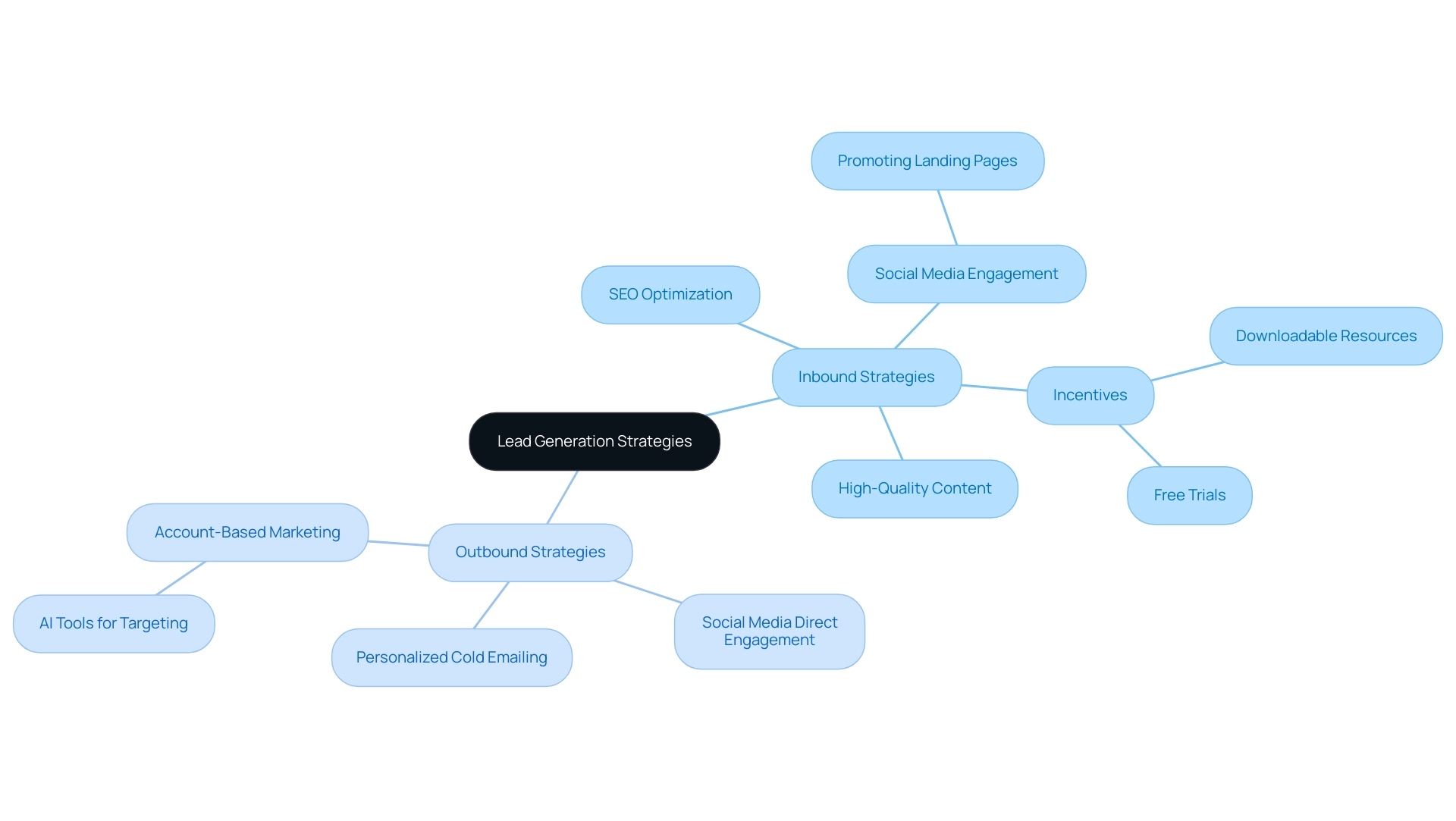
Integrating inbound and outbound strategies for maximum impact
Integrating inbound and outbound lead strategies creates a dynamic framework for generating prospects that truly caters to diverse business needs. We understand that small business owners often grapple with how to spark immediate interest among potential clients. Outbound methods, like targeted outreach, can be a powerful tool in this journey. At the same time, nurturing these relationships is essential. By understanding the dynamics of inbound and outbound leads, businesses can deliver valuable, search-optimized content and personalized follow-ups that resonate with the specific challenges and interests of their audience.
By combining these approaches, companies not only expand their reach but also enhance the quality of their prospects. This ensures that potential clients remain engaged and informed throughout their journey. It’s crucial to recognize that the average B2B sales process in 2024 took 25% longer than it did five years ago. With 81% of sales groups investing in AI, there’s an opportunity for companies to refresh their prospect generation strategies, improving customer interactions and data quality.
Ultimately, this integration can lead to significantly higher conversion rates. Take the successful case study of Pointe Pest Control, for instance. They saw their acquisition costs drop dramatically from $104 to just $10 by focusing on a cohesive strategy that effectively balances inbound and outbound leads. As they noted, ‘The business went from paying $104 to just $10 per contact.’ This illustrates how frameworks like these not only enhance prospect generation but also leverage the strengths of both methodologies, underscoring the importance of a holistic approach in today’s competitive landscape.
Additionally, it’s important to acknowledge that door-to-door sales continue to generate nearly $30 billion annually. This highlights the enduring relevance of traditional methods, even as the world becomes increasingly digital. You’re not alone in navigating these challenges — embracing a blend of strategies can empower your business to thrive.

Leveraging technology for enhanced lead management
In 2025, technology serves as a vital ally in optimizing client management. We understand that managing clients can feel overwhelming, but automation is here to help streamline those routine tasks while providing critical insights into client behavior. Platforms like Dashly lead the way, offering specialized tools for capturing, nurturing, and reactivating prospects, making engagement across various channels not just a possibility but a reality. Imagine leveraging chatbots and multi-step campaigns — Dashly ensures that prospects are not only captured but effectively nurtured toward conversion.

The integration of Customer Relationship Management (CRM) systems enhances this process even further. These systems empower teams to meticulously track interactions and manage follow-ups, ensuring that no prospect slips through the cracks. This thoughtful approach significantly increases the likelihood of conversion — especially important considering that only 21% of prospects convert to sales. Dashly addresses this challenge head-on by automating prospect follow-ups and providing customized engagement strategies that keep interest alive.
Moreover, automated analytics offer invaluable insights into prospect quality and engagement levels. By analyzing data, businesses can refine their approaches and prioritize outreach to high-value clients. As noted by HydroWorx:
- “Our marketing department has a lot of key performance indicators that WebFX has always helped us achieve… WebFX has always worked hard to make sure that we’re getting what we need out of the partnership, not just what may seem like the best result.”
This underscores the importance of technology in managing prospects effectively.
In a world where an estimated 361.6 billion emails are sent daily, the potential of effective email marketing is immense. It highlights the necessity for robust management strategies to capture and nurture prospects successfully. Additionally, with Instagram boasting 1.4 billion active users, particularly among those aged 18 to 24, leveraging social media for customer acquisition is more crucial than ever. Utilizing tools like Dashly empowers businesses to harness the full potential of technology, transforming lead management into a strategic advantage in the competitive landscape of 2025.

Optimize your funnel with marketing automation tools from Dashly:
Conclusion
Understanding the nuances between inbound and outbound lead generation is essential for businesses like yours that aim to optimize marketing strategies. Inbound leads, generated through valuable content and engagement, foster deeper relationships and higher conversion rates. On the other hand, outbound leads, achieved through proactive outreach, often yield immediate results but may lack the same level of engagement. Each approach comes with its own set of advantages and challenges, and the key to success lies in recognizing how to effectively integrate both strategies.
By combining inbound and outbound methods, you can create a comprehensive lead generation framework that not only expands your reach but also enhances lead quality. This strategic alignment allows for a seamless customer journey, accommodating various stages of engagement and ensuring that prospects remain informed and interested. As technology continues to evolve, leveraging tools like automation and AI can significantly improve lead management, facilitating better insights and more effective nurturing processes.
As the marketing landscape becomes increasingly competitive, embracing a holistic approach to lead generation is not just advantageous but necessary. By understanding and implementing the strengths of both inbound and outbound strategies, you can drive growth, enhance customer relationships, and ultimately achieve your acquisition goals. The future of successful marketing lies in your ability to adapt and innovate, ensuring that both methodologies work in harmony to create a lasting impact.



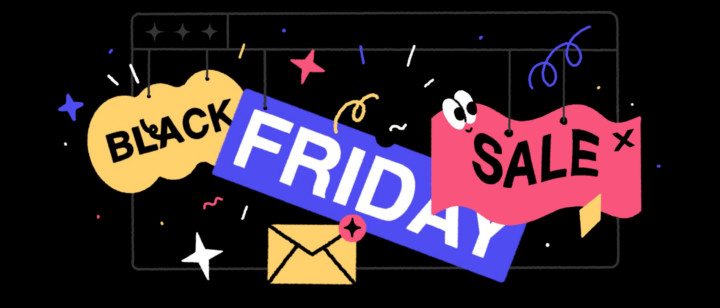

![Autofunnel complete guide: what is it and how to design + [free checklist]](https://www.dashly.io/blog/wp-content/uploads/2020/02/funnel-720x297.gif)


